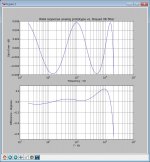Thank you luckythedog for explaining.
Is there any difference btn a certain analog filter and it’s digital IIR implementation?
Very little, the z transform is an analog of the Laplace transform in the s domain. In the limit of infinite sampling frequency they are equivalent. For finite sampling frequency the poles and zeros (including the zero at infinity) are "warped" to a best fit. See below RIAA at 96k with single biquad IIR. Of course the error increases as you approach Nyquist but even at 44.1 only two biquads fit impressively out to 20k.
Attachments
Last edited:
I had a play with Samplitude (IIRC) declicking, denoising and declipping restoration/processing.
All processes had adjustments that required careful attention, but the result was quite satisfying.
I also played with LP recorder denoising/declicking.
I don't know what smart software is available nowadays, but it's worth Googling.
Dan.
I did some playing with ClickFix plug-in for Cooledit/Audition and was impressed especially how well it filled in big clicks. His algorithm for finding real music was interesting in that it worked noticeably less well on a test record or music that was not de-emphasized.
That's a bit farfetched - we all know (don't we) that the harmonics of inaudible low bass notes give us a perception of bass notes. Some manus even use that - if there is say 50Hz in a piece of music, synthesize 100 Hz and 150 Hz and you can leave out the 50 Hz with no bad effects.
So why is KEF disredarding this and come up with an outlandisch story? Occams' Razor comes to mind.
Jan
???
Jan...... this outlandisch description is what is given in every AES and other paper on the sound of high GD at low freq.... that is why. Even in some of the ones I just put up here recently.
THx-RNMarsh
Well obviously the filter MUST have some audible effect, otherwise you wouldn't use it. How do we know that the audible difference we DO hear is what we want, or if there is an aspect of the audible difference we do not want? How can we ever know what the difference is? Do we have an idea of what the difference is in sound between a low GD or high GD or nonlinear GD HP filter?
If as I suspect from all the posts here avoiding the beef, we indeed have no clue what it is we are wishing to hear - or not to hear.
It reminds me of a statement my boss once made at an air operations planning session: if you don't know where you're going, any road will take you there.
Jan
Are you serious? Removing non-musical junk at sub audio freqs from the PA and speaker has no positive attributes related to the recorded music?
The only real issue is how to make a HP filter with low enough GD so it isnt audible when switched in. [boomy and muddy bass]
THx-RNMarsh
Last edited:
You could A-D digitize the incoming MM or MC signal from the cart and then D-A it and feed that back to emulate a single active gain/EQ stage.
To deal with the latency issue, you would cal that out. A bit of DSP would take care of subsonic issues.
However, to my mind an opamp is a singularly hard option to best on a performance and cost basis. I disagree with JC in the filter - you need it - just make it switchable.
To deal with the latency issue, you would cal that out. A bit of DSP would take care of subsonic issues.
However, to my mind an opamp is a singularly hard option to best on a performance and cost basis. I disagree with JC in the filter - you need it - just make it switchable.
If I was going to make a laser turntable I would combine an optical profilometer with optical coherence tomography (for dust and depth of groove choice) with image targeting to follow the track. Maybe I would integrate the dust or scratches out. This could be done in the analog domain for the grove and digital for the tracking. Just saying.
Last edited:
My first thinking about all this subsonic sound going to most speakers is how many can possibly reproduce a true 20 hz frequency response? I don't think there are more than a handful of reproducers that can do that. Most 15" or even 18" bass drivers are not tuned that low, that would be the outlier that can do that. Now get into a smaller sized device and the excursion needed to produce an audible output that low would drive them into such a high distortion area with the voice-coil in most short gap designs it would be horrendous. Most people when listening to music and not a sound track for a movie seems to be more than happy with the bass with a peak response is in the 60hz range, this is what JBL and most others did for years, accentuate that area and forget about anything that is truly a fundamental below that range. I have made bass horns that would go that low, but why do it, the only people who knew I was doing that were the neighbors who were more than a bit perturbed by that low frequency leaking into their house.
I guess a bunch of you must listen to organ music or some kettle drums to need to get that low, I'll just use the low pass filter and cut that out if I see a cone dancing away and not hearing anything useful down that low.
I guess a bunch of you must listen to organ music or some kettle drums to need to get that low, I'll just use the low pass filter and cut that out if I see a cone dancing away and not hearing anything useful down that low.
Thanks for unearthing that. I believe that his retail product was different however---the one that left him disgruntled, as the reviewers were not particularly impressed. In that one (I guess I could ask him for a schematic) he said he had the 75us tau at the JFET drains. In the magazine/kit article he has a ~flat instrumentation amp configuration.Pages 71-76
http://www.americanradiohistory.com/Archive-Poptronics/80s/1981/Poptronics-1981-03.pdf
I located it thanks to forr input http://www.diyaudio.com/forums/analogue-source/122129-solid-state-phono-preamp-design-philosophy-7.html#post1518394
George
The solar sail craft has become unresponsive due to an overflow condition they knew about---but couldn't upload a fix in time, I was just reading. They are hoping for a cosmic ray to accomplish a reset!I'm not commenting I'm just putting up photos of fixed with software... these are just extreme cases.
Like the flight stability of these control surfaces...
Like this ugly duckling...
Software problem "pauses" LightSail mission
The most impressive low bass I ever heard, not overly exaggerated, was at Disney Hall when the Phil did the Strauss Also Sprach Zarathustra (a revelatory performance, as if I was hearing the familiar piece for the first time). But the scariest was at Toole's house in his room with carefully-placed multiple subwoofers. Same piece, but from a CD that had the levels on the recording of the organ cranked way higher than the score specifies---essentially just a demonstration recording. The instinctual response, despite knowing better, was to rush to a door jamb, until it was clear that there was a low-frequency cutoff and it was not The Big One.My first thinking about all this subsonic sound going to most speakers is how many can possibly reproduce a true 20 hz frequency response? I don't think there are more than a handful of reproducers that can do that. Most 15" or even 18" bass drivers are not tuned that low, that would be the outlier that can do that. Now get into a smaller sized device and the excursion needed to produce an audible output that low would drive them into such a high distortion area with the voice-coil in most short gap designs it would be horrendous. Most people when listening to music and not a sound track for a movie seems to be more than happy with the bass with a peak response is in the 60hz range, this is what JBL and most others did for years, accentuate that area and forget about anything that is truly a fundamental below that range. I have made bass horns that would go that low, but why do it, the only people who knew I was doing that were the neighbors who were more than a bit perturbed by that low frequency leaking into their house.
I guess a bunch of you must listen to organ music or some kettle drums to need to get that low, I'll just use the low pass filter and cut that out if I see a cone dancing away and not hearing anything useful down that low.
Another amazing acoustical event I may have related occurred at Lick Observatory, Mt. Hamilton, above San Jose, CA, circa 1982. We had just gotten to sleep in the blackout-curtained dormitory after a long night of observing at the 3 meter, when we were all (I presume, unless someone was one of those nearly-comatose in the early stages) awakened by an incredibly loud and very-low-frequency sustained noise. I think it went on for a couple of minutes. Many jumped out of bed and stood in the nearest door jamb. It was from a relatively-nearby (still several miles) static rocket engine test. The Physics 101 question at lunch: given the thrust and duration, how much was the Earth's orbit perturbed?
The F-117 was gorgeous. Ugly indeed, hmmph.
Of course it is gorgeous it has a V tail as do all the best planes.
Would not the original master tapes be of a higher effective resolution than the record produced from it though.
The original tapes may have deteriorated enough over the years that the master disc would be better.
The late great Doug Sax once opined that the metal master was the least-volatile recording of all. This was back in the infancy of digital.The original tapes may have deteriorated enough over the years that the master disc would be better.
John, I think that is true in all fields of engineering. I hate when some say "we can fix it with software" when the designed is fundamentally flawed.
They just say that when they don't know anything about hardware.
- Status
- Not open for further replies.
- Home
- Member Areas
- The Lounge
- John Curl's Blowtorch preamplifier part II


